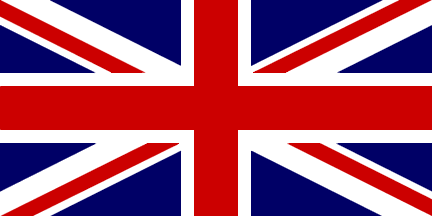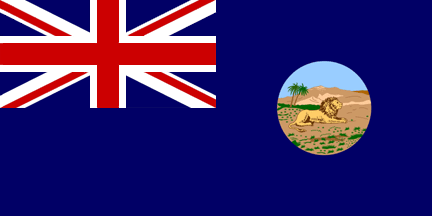 (1:2)
image by Clay Moss, 18 Dec 2006
(1:2)
image by Clay Moss, 18 Dec 2006 
Last modified: 2022-10-22 by bruce berry
Keywords: south africa | transvaal | lion |
Links: FOTW homepage |
search |
disclaimer and copyright |
write us |
mirrors
 (1:2)
image by Clay Moss, 18 Dec 2006
(1:2)
image by Clay Moss, 18 Dec 2006
h!.gif) image by António Martins-Tuválkin, 26 Dec 2007
image by António Martins-Tuválkin, 26 Dec 2007
The proposed badge for the Union Jack of the British Administrator
Transvaal was cancelled
in 1884. It was based upon a supposed Public Seal. When the Admiralty
were informed that no Public Seal had been approved for Transvaal the badge
was cancelled.
David Prothero, 16 May 2002
Seems like the dexter part is a Union Jack without St. George's cross.
On second thoughts, maybe it was the so called "Burgers
flag"? (the national flag of the Zuid-Afrikaansche Republiek from Oct.
1874 till May 1875).
Mark Sensen, 16 May 2002
 image
by Clay Moss, 27 Mar 2007
image
by Clay Moss, 27 Mar 2007The Zuid-Afrikaansche Republiek was renamed the Crown Colony
of Transvaal following the British triumph in the Anglo-Boer War.. It adopted a
Blue ensign with lion couchant badge in the fly which was in use between 1902
-1910, after which the Colony became the Transvaal Province in the
Union of South Africa.
Bruce Berry, 07 Oct 1996
 image
by Clay Moss, 22 Jan 2008
image
by Clay Moss, 22 Jan 2008
You illustrate the flag of the Transvaal after the Anglo-Boer War, as
a blue ensign with a badge of a lion. This flag never existed, not
even on paper. It is an assumption made on the basis of common practice
elsewhere, and erroneously attributed to this case. No Admiralty
warrant exists for it. If it were used on a flag at all (and I seriously
doubt that it was) then it was a circular badge in the centre of the Union
Flag.
Michael Faul, 22 Jul 2002
Michael Faul is of the opinion that no Transvaal Blue ensign after the
Anglo-Boer-South African War of 1899-1902 actually existed. He is
correct in saying that no Admiralty Warrant existed for this flag but the
badge is illustrated in Flags, Badges and Arms of the British Dominions
beyond the Seas (Part I - Flags and Badges (HMSO, 1910). Brownell
in The Union Jack over Southern and Central Africa 1795-1994
[brl94] states that usage of this flag was probably limited given the political
situation at the time. Certainly the Cape and Natal colonies had
distinctive ensigns so it is not unreasonable to assume that the Orange
River Colony and the Transvaal should have done likewise. Given that
the Union of South Africa was shortly to follow in 1910, it is not surprising
that no Admiralty Warrant for a flag was issued.
Bruce Berry, 22 Jul 2002
As far as I know colonial (and departmental) Blue Ensigns were the subject
of internal Colonial Office/Home Office/Admiralty arrangements and no warrants
were ever issued for them. Warrants were issued only for colonial Red Ensigns,
yacht club ensigns, and merchant ship Blue Ensigns granted under Naval
Reserve and Admiralty subvention regulations. They were required
by law in order to comply with merchant shipping legislation. The Transvaal
badge was added to the 1889 Admiralty Flag Book, as an amendment, in February
1904, and included in the 1907 edition.
David Prothero, 22 Jul 2002
While I don't have access to archival information as Michael Faul appears
to have, I can confirm that Fred Brownell (in National and Provincial
Symbols, 1993) [brl93] asserts the existence of the Transvaal Blue Ensign.
He does not mention a royal warrant, but he makes this comment:
"Despite the fact that the Colony certainly had no shipping of its
own, by 1905 its colonial flag device was even to be found included in
the Imperial German Navy's Flag Book. For years after Union, the Transvaal
Colony's Red Ensign was also still to be found depicted in flag books."
It is most unlikely that the State Herald (as Brownell was in 1993)
would knowingly publish information on a non-existent flag. The badge,
he states, came from the colonial seal. Both seal and badge are illustrated
on my
page these illustrations being scanned from National and Provincial
Symbols.
Incidentally, whether or not the Blue Ensign was used much in the Transvaal,
there would almost certainly have been a Union Jack defaced with the badge,
since the Governor, Lord Milner, lived in Johannesburg during most of the
period from the annexation of the Zuid-Afrikaansche Republiek until his
resignation. Milner (Sir Alfred when he was first made Governor of the Orange River Colony) resigned as Governor of the Cape so that he could
take personal charge of arrangements in the former Boer republics, although
he retained his position as High Commissioner. When he was made Governor
of both the Orange River Colony and the Transvaal, he appointed Administrators for the
two colonies. The Administrators lived respectively in Bloemfontein and
Pretoria, and reported to him on their activities. Although Pretoria remained
the seat of administration for the Transvaal, Milner preferred to remain
in Johannesburg.
Mike Oettle, 22 Jul 2002
The basic objection to this design is that it was never warranted by
the Admiralty. Only the Admiralty could authorise a defacing badge on either
the blue or the red ensigns.
Michael Faul, 23 Jul 2002
 image
by Clay Moss, 05 Apr 2007
image
by Clay Moss, 05 Apr 2007
Here's my attempt at an image of the
Administrator's flag for the Transvaal Colony. I am assuming that such a flag was at least drawn up on paper for the
Transvaal Colony, whether it was actually used or not.
Clay Moss, 05 Apr 2007